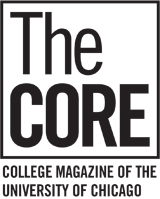Charting a New Course
A chance conversation that throws off sparks. A fresh research direction. A finger on the student pulse. How do faculty get new course ideas? Let us count the ways.
By Katherine E. Muhlenkamp, Benjamin Recchie, AB'03, and Elizabeth Station | Photos by Beth Rooney
The math is both simple and heartbreaking. Assuming that College students take four courses a quarter for four years, with no overloading, they have just 48 slots to fill. But the 2010-11 course catalog lists more than 2,200 possible courses to fill them with.
And if that weren't agonizing enough, new courses are constantly being added. This year, about 20 percent of the listings—448 courses—were being offered for the first time. (That number doesn't include new graduate courses, which undergrads can usually talk their way into without much difficulty.)
"There is no College-wide committee that approves new courses," says Dean John W. Boyer, AM'69, PhD'75. "We hire the eminent people in their fields, so we trust our faculty." Core courses, which must be approved by the collegiate masters and ultimately by Boyer, are the exception: "The Core tends to change slowly, in an evolutionary way. But Core courses are dynamic in that the faculty are always revisiting the readings."
According to academic stereotype, new courses come about because professors want to teach their next book or article. That's often true, especially at the graduate level, says Boyer, whose first self-designed course explored the intellectual and cultural history of late imperial Vienna. ("I still have the syllabus," says Boyer, who in 2006 received the Austrian State Prize for Modern History. "It was a good course.") Sometimes the genesis of a new course is less stereotypical, as writers Katherine E. Muhlenkamp, Benjamin Recchie, and Elizabeth Station discovered this fall when they went back to class.
Anthropology 26505
Non-Industrial Agriculture
Last year, anthropology professor Kathleen Morrison noticed a trend: many of her environmental studies and anthropology students were increasingly excited about topics related to contemporary agriculture—sustainability, invasive species, genetically modified organisms. Some of them worked at urban gardens in Chicago.
"It seemed to me," says Morrison, "that while they were all very sweet, energetic, activist students, they had an underdeveloped sense of how agriculture actually works." By February, she'd begun to create an elective course, crosslisted for undergraduates and graduate students, called Non-Industrial Agriculture. While industrial agriculture became the standard in developed nations only in the 1940s, non-industrial agriculture—farming without petrochemicals or the use of fossil fuels—has been around for 10,000 years. Its history and related scholarship, Morrison explains, are vast troves of knowledge that can illuminate current agricultural issues.
She points to research on swidden farming, often used in tropical environments and also known as "slash-and-burn agriculture," as one example. A practice that's been in use for thousands of years in some countries, it has been taken up recently in more: "when it makes sense for people to farm this way, they do," Morrison says. Swidden farming is generally perceived as disorganized and environmentally destructive in the United States, she remarks, in spite of anthropological research that shows another side: "it's actually, in many cases, beautifully set up to mimic the structure of the natural rain forest."
And so Morrison, an archeologist who studies the history of agricultural change in India, created a new class where historical and ethnographic research inform contemporary concerns. She started by determining a set of topics, such as plant breeding basics and the role of farm animals, and then thinking about what books she should use, "because I wanted to expose students to this huge anthropological literature about what's usually called 'traditional farming.' It's really scattered and it took me my whole career to learn that literature—there isn't a single book that tells you all about it." She ultimately decided on four required texts, each covering a different area: agrodiversity, i.e., growing more than one type of crop or using different strategies to grow the same crop; intensive forms of agriculture, or agriculture that yields a high output per unit area; the cultural dimensions of agriculture, such as the reasons beyond sustenance that certain cultures grow certain foods; and the innovations of non-industrial farmers.
Morrison spent the first class session outlining the subject matter and some common misconceptions about non-industrial agriculture. For instance, she said, this type of farming should not be classified as subsistence agriculture because, in some cases, it supports entire cities.
The fact that 35 students were there, said Morrison, showed that "agriculture is cool again" and that students are concerned about how modern farming affects social justice, the environment, culture, and human health. "But if you don't want the world set up in terms of industrial agriculture," she continued, "meaning endless rows of corn and soybeans, you need to have a realistic view of what the alternatives are. The longer-term historical record can show us when and how things worked and under what conditions."
By early November, Morrison was into the nitty-gritty of those alternatives, discussing rice production. Land that is under paddy rice for a long time, she said, starts to produce "paddy soils." "Think of paddy—remember that it's holding water some of the time but not all of the time—as a flat pan that holds water," said Morrison, chalk-sketching a rough diagram of soil layers and rice. "This hardpan is a feature of production—like a liner in the bathtub that holds water in." She described the ideal soil for growing paddy: "like a creamy mud, or chocolate pudding of sorts." Such soil helps retain water—and water is what provides nutrients.
"In growing paddy," she said, "it's much more about the water than it is about the soil." Growing wet rice changes the soil, creating an optimal environment for continuing to produce rice. "Once you've started growing rice, there's no getting out of it," said Morrison. "You don't go back. Well, of course there is sometimes going back, but it changes things.—K.E.M.
Agriculture is cool again.
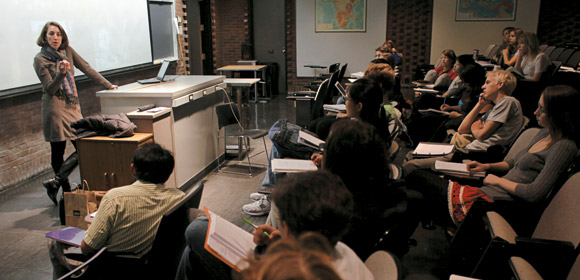
Kathy Morrison shows students eight different varieties of domesticated rice, or Oryza sativa.
Big Problems 23000
Cosmos and Conscience: Looking for Ourselves Elsewhere
By definition, a Big Problems course deals with messy, sprawling subjects—matters of global concern, involving multiple disciplines. Cosmos and Conscience: Looking for Ourselves Elsewhere, cotaught by astrophysicist Don York and ethicist William Schweiker, doesn't disappoint. The big problem at hand, explains York, is, "Given what we know and given the limitations about what we know, how do you choose to live your life?"
Cosmos and Conscience began with a fix-up. William Wimsatt, then the head of the Big Problems course at the New Collegiate Division, which sponsors the Big Problems classes, contacted York and inquired whether he would be willing to coteach a class. (All Big Problems courses are team taught.) York remembered a conference on the history of astronomy that he had helped to organize in China a few years ago. "Until 1500 or so, China was far ahead of the West in science and technology," he says. "But after the invention of the telescope, everything changed."
The realization that the same physical laws held sway both in the heavens and on Earth paved the way for a spirit of inquiry in the West, whereas in China, "If you found something new in the heavens, well, that was just the way the heavens were and you just hadn't found it yet." The lesson to be learned: "If you think you know something, your knowledge may be biased by the way you ask your questions and the culture that you live in."
York proposed to the New Collegiate Division teaching a class based on this idea. They liked his train of thought and introduced York to William Schweiker from the Divinity School, leaving the structure and nature of the class up to them.
York and Schweiker realized that their respective fields had one notable point of overlap—Immanuel Kant. While better known for his philosophical works, he was also, says York, "the first person who recognized that the universe is probably extremely large, much larger than the solar system." Kant posited that what astronomers then understood only as fuzzy patches on the sky were in fact "island universes," galaxies like our own Milky Way with millions of stars.
Over a series of breakfast meetings at the Quadrangle Club, the two men hashed out an idea—and a syllabus. But with just a week to go before classes started, Schweiker suddenly took ill, and it looked like York might be pressed into teaching the class on his own for a while, including the sessions on philosophy, something he hadn't studied since his own college days. "I told [Schweiker] I 'Kant' do the whole course," York quips.
When the first day of class came, Schweiker was there, none the worse for wear. The room was nearly full (the class roster had filled up by July), with several unregistered hopefuls who wanted to add the class. All of the 25 students in attendance on day one were third- and fourth-years; only a handful were concentrating in the hard sciences.
York and Schweiker took turns introducing the class. First Schweiker explained the basics of ethics and morals—morals are a set of beliefs, values, or practices, whereas ethics asks whether morals are true—and introduced a few of the questions the course would explore: What is the relationship between knowledge and truth? What is religion? How do science and religion relate to ethics?
One student raised her hand. "Does ethics assume a singular truth?" she asked.
"You've anticipated one of the questions of the course," Schweiker responded.
When his turn came, York explained Kant's role as the "crossing point" of the class, the nature of galaxies as island universes, and how the development of the telescope changed humanity's conception of its place in the universe. At one point, he mentioned that the theory of multiverses suggested that dozens of copies of this class and its students exist elsewhere. "But that still means you have to write your own papers," he deadpanned. "And no copying!" interjected Schweiker.
At the end of the class period, Schweiker said he would sign the add/drop slips for any student wishing to add the course—"if we haven't completely scared you off." Judging from the swarm that formed around him, no one was dissuaded.—B.R.
Your knowledge may be biased by the way you ask your questions.
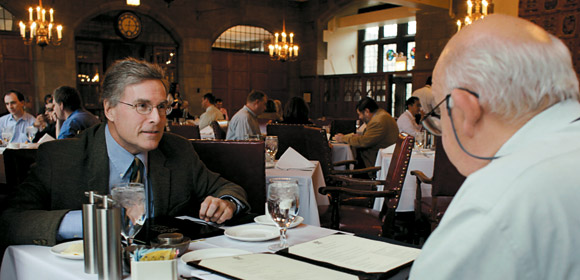
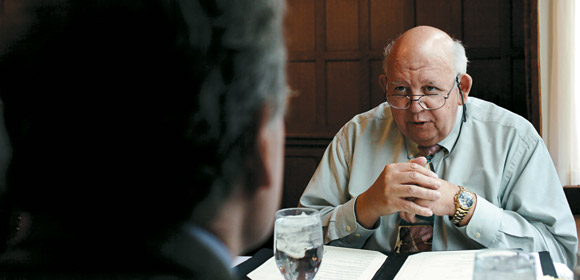
Let's do lunch: Schweiker and York mapped out their course over meals at the Quad Club.
Art History 10100
Introduction to Art
Strictly speaking, Introduction to Art—also known as Art 101—isn't a new class. For decades, College students have taken it to fulfill their Core requirement in the dramatic, musical, and visual arts. At some schools, such courses offer a sweeping, chronological survey of major Western artworks from the caves of Lascaux to the kitsch of Jeff Koons. At Chicago, instructors have been free to introduce students to art as they see fit.
That changed in 2008, when the art history department revamped the course to make it more collaborative, predictable, and engaging for faculty and students. Now, each instructor builds his or her syllabus by selecting from a set of nine thematic modules created by colleagues in the department. Each module is short and can be covered in a week or two. The topics—funerary art in classical Athens, medieval sacred versus secular love, Chinese painting and calligraphy, among others—reflect faculty research interests.
Niall Atkinson, one of four instructors who taught Art 101 this past fall, says the course isn't designed "to teach students so they can sound informed at cocktail parties." Emphasizing critical concepts rather than names or dates, he aims to give students "not only the tools with which they can confront objects in a museum but also an apparatus with which they can interpret the visual world around them."
A historian of architecture and urbanism, Atkinson earned his PhD from Cornell in 2009 and joined the faculty this past August as a Neubauer family assistant professor in art history. As he unpacked boxes in his Cochrane-Woods Art Center office and settled into his new home in a Mies van der Rohe building in Hyde Park, he designed a new module for the course on the art of city building.
Cities are at the heart of Atkinson's scholarship; he wrote his dissertation on architecture and urban space in late medieval and early Renaissance Florence. His module—the first to focus on architecture—looks at utopian approaches to city planning and the ways people experienced urban environments in different times and places.
For course readings, he's steering students toward innovative historiography like Diane Favro's recreation of a walk through Rome in 52 BC: "I want them to get an idea of how a historian can, as a narrative technique, take you through a city and make you know [it] by imagining you were there." Atkinson also likes primary sources, believing that Walter Benjamin's essays on nineteenth-century Paris and Filippo Marinetti's Futurist Manifesto provide a stronger sense of time, place, and attitude than a survey textbook can.
To round out his syllabus, Atkinson has chosen five modules prepared by colleagues who have taught or are currently teaching their own sections of Art 101. Before classes began, he met with fellow instructors and adapted lesson plans, lecture notes, images, and readings they had uploaded to a shared web space. "This is a course which is, in a way, built the way a wiki is built," he says—that is, course content can be refined as participating faculty alter existing modules and expanded when they create new ones.
To launch his unit on city building, Atkinson wants to explore the notion of ideal cities as conceived by the Italian architect and sculptor Filarete (c. 1400-1469). For a Tuesday session, he has asked students to read excerpts from Filarete's Treatise on Architecture and post comments to the course's online discussion site before class. Forty percent of their grade comes from online and in-class participation, but the 13 students are mostly quiet as Atkinson works his way through slides and notes.
Architects from Vitruvius to Leonardo da Vinci viewed the geometry of the human figure as the source for the proportions of buildings, Atkinson explains. Filarete's drawings for Sforzinda—a circular Renaissance city that was never built—echoed this ideal. Filarete hoped that architects, by creating good cities, could create a good society. "Putting a brothel next to a church wouldn't promote the kind of behavior that a church wants," Atkinson observes. "All these things are part of a city, but they have to be organized a certain way."
Changing gears, he asks students to comment on a reading about Masdar, a planned city being built outside Abu Dhabi in the Arabian desert. "What's similar about Masdar and Filarete's town, or the Garden of Eden, or Jerusalem?" asks Atkinson. The class perks up, noting how Masdar, a contemporary utopia, has different priorities—efficiency, environmental sustainability—but embraces ancient ideals: it's laid out as a perfect raised square.
As a closing salvo, Atkinson shows a slide of Palmanova—a perfectly designed sixteenth-century fortress city that no one wanted to live in. He quotes historian Edward Muir, who wrote that planned cities "look intriguing on paper but were not especially successful as livable spaces.""Think about that when you think about what's in the future for Masdar," says Atkinson as the students depart. "Can utopia ever, ever prevent its own complete annihilation? I'll see you on Thursday."—E.S.
Art 101 isn't designed "to teach students so they can sound informed at cocktail parties."
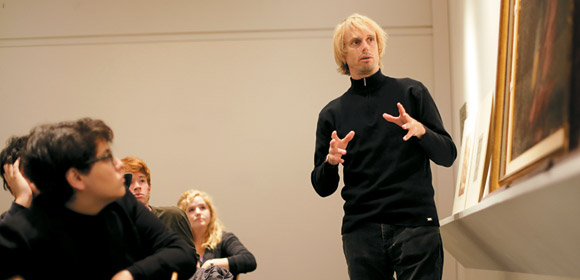
"This is a way of team-teaching without actually having the team there," says Atkinson. "You open up the module and you see where you go."
